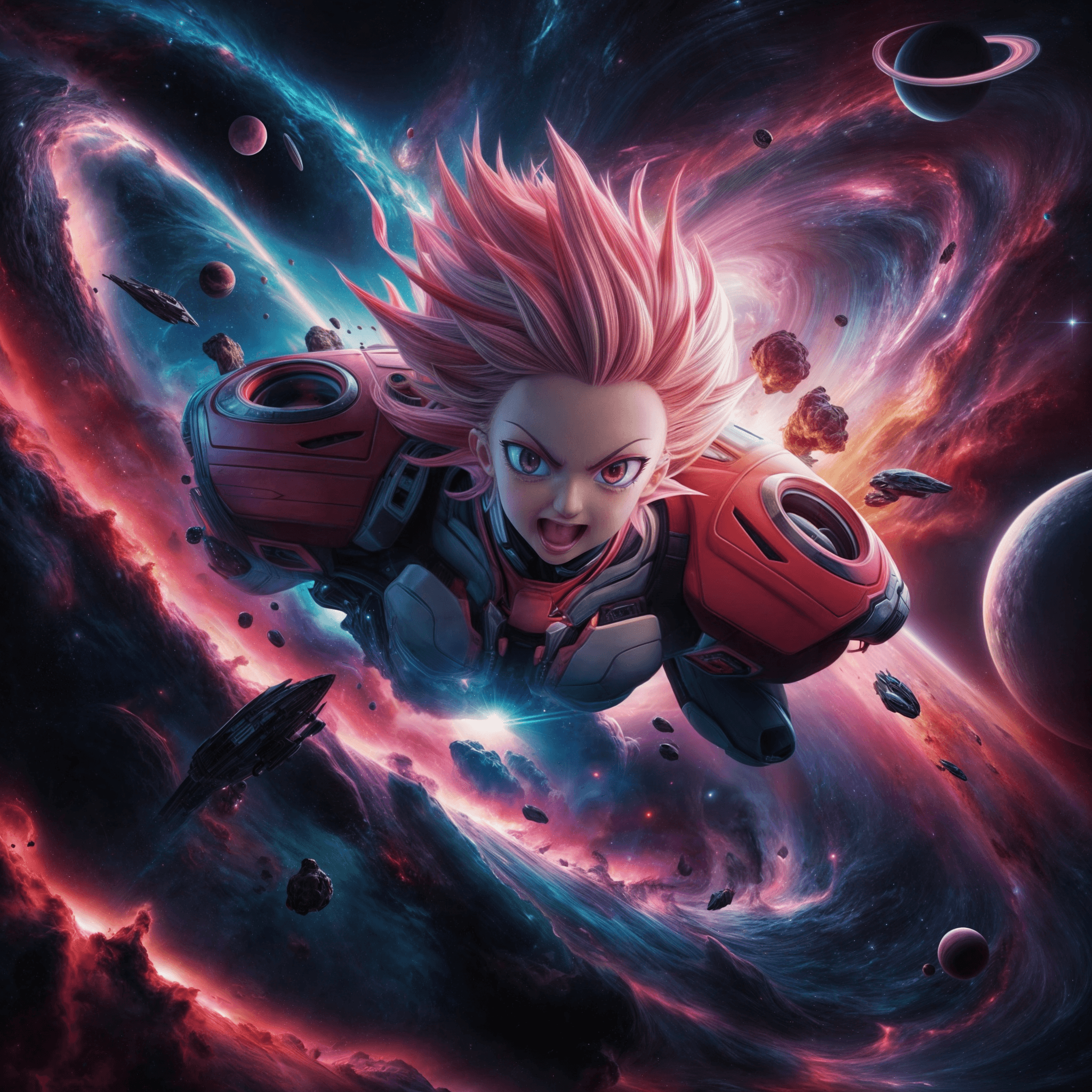The History of Anime
Dinis GuardaAuthor
Tue Feb 25 2025

Anime, an artistic and cultural phenomenon, has its roots in early 20th-century Japan and has since grown into a global entertainment powerhouse. This chapter explores its evolution chronologically, highlighting the key figures, trends, and landmark works that shaped the industry.
The History of Anime – A Journey Through Time
Anime, an artistic and cultural phenomenon, has its roots in early 20th-century Japan and has since grown into a global entertainment powerhouse. This chapter explores its evolution chronologically, highlighting the key figures, trends, and landmark works that shaped the industry.
1. The Birth of Japanese Animation (1917–1930s)
Early Experimentation and the First Anime Films
Japanese animation began in the 1910s, influenced by Western pioneers like Émile Cohl, Winsor McCay, and Walt Disney. The earliest known anime films were experimental short works created by independent artists, using rudimentary animation techniques.
- ?ten Shimokawa (1892–1973) – Often credited as the first anime creator, Shimokawa was a political cartoonist who transitioned into animation. His first known work, Katsud? Shashin (????, Moving Picture), was made in 1917, though no copies survive.
- Jun’ichi K?uchi (1886–1970) – A key figure in early anime, K?uchi created Namakura Gatana (?????, The Dull Sword, 1917), which humorously depicted a samurai wielding a dull sword. This remains one of the earliest surviving Japanese animations.
- Seitar? Kitayama (1888–1945) – An independent filmmaker, Kitayama was a pioneer in hand-drawn animation, utilizing paper cutouts and early cel animation techniques. He founded Kitayama Eiga Seisakujo, Japan’s first animation studio, in 1921.
Trends and Influences in the 1920s–1930s
- Kamishibai (???) – A popular form of street storytelling that influenced anime’s dramatic narration and character design.
- Paper Cutout and Chalk Animation – Due to the high cost of celluloid, many early animators used paper and chalk drawings to create movement.
By the 1930s, animation had begun to integrate sound and was used for educational and political messaging, foreshadowing its role in propaganda films during World War II.
2. War and Propaganda (1930s–1945)
As Japan moved toward militarization, anime was increasingly used for propaganda. The government funded animations to promote nationalism and war efforts.
- Mitsuyo Seo (1911–2010) – A key director of wartime animation, Seo created Momotaro: Umi no Shinpei (????????, Momotaro, Sacred Sailors, 1945), Japan’s first feature-length anime. The film, commissioned by the Imperial Navy, depicted the legendary hero Momotaro leading animal soldiers against Western forces.
During this period, animation was largely controlled by the government, limiting its artistic expression. However, the techniques developed during this time would later influence post-war creators.
3. The Post-War Era and the Rise of Television Anime (1945–1960s)
After World War II, Japan underwent rapid reconstruction, and the entertainment industry began to flourish. Animation evolved from wartime propaganda to commercial storytelling, driven by pioneers who set the foundation for modern anime.
Osamu Tezuka: The Father of Anime
- Osamu Tezuka (1928–1989) – Often called the “God of Manga” and the “Father of Anime,” Tezuka revolutionized Japanese animation. Influenced by Disney’s Bambi and Snow White, he introduced cinematic techniques such as close-ups, dynamic angles, and expressive character designs.
- Astro Boy (Tetsuwan Atom, 1963) – Tezuka’s Astro Boy was Japan’s first serialized TV anime and introduced many hallmarks of modern anime, including episodic storytelling and iconic “big-eyed” character designs.
The Birth of Anime Studios
- Toei Animation (founded 1956) – Japan’s first major animation studio. Toei aspired to be the “Disney of the East,” producing films like The White Snake Enchantress (1958), Japan’s first full-color animated feature.
- Mushi Production (founded 1961) – Established by Tezuka, this studio played a critical role in launching TV anime, producing Astro Boy, Kimba the White Lion, and Princess Knight.
Notable Films and Trends
- Hakujaden (The White Snake Enchantress, 1958) – Japan’s first color animated film, influenced by Chinese folklore.
- The Emergence of Sh?nen and Sh?jo Anime – Genres catering to young boys (sh?nen) and girls (sh?jo) emerged, with Princess Knight pioneering the magical girl genre.
4. The Golden Age of Anime (1970s–1980s)
The 1970s and 1980s saw the birth of modern anime as we know it, with studios producing groundbreaking series and films that established enduring franchises.
Key Figures and Studios
- Leiji Matsumoto (1938–2023) – Creator of Space Battleship Yamato (1974) and Galaxy Express 999 (1977), which defined space opera anime.
- Go Nagai (b. 1945) – Revolutionized mecha anime with Mazinger Z (1972), introducing the concept of giant piloted robots.
- Hayao Miyazaki (b. 1941) & Isao Takahata (1935–2018) – Founders of Studio Ghibli, renowned for their masterful storytelling.
- Notable Anime and Films
- Mobile Suit Gundam (1979) – Created by Yoshiyuki Tomino, this series introduced “real robot” mecha, where robots were treated as military machines rather than invincible heroes.
- Akira (1988) – Katsuhiro Otomo’s cyberpunk masterpiece, which introduced anime to Western audiences and demonstrated the artistic potential of the medium.
- Nausicaä of the Valley of the Wind (1984) – Directed by Hayao Miyazaki, this film paved the way for the founding of Studio Ghibli.
5. The Global Expansion of Anime (1990s–2000s)

By the 1990s, anime had gained mainstream recognition worldwide, driven by TV syndication, home video releases, and the rise of internet fandom.
The Rise of Internationally Acclaimed Anime
- Dragon Ball Z (1989–1996) – Akira Toriyama’s legendary sh?nen series that became a global phenomenon.
- Neon Genesis Evangelion (1995) – Hideaki Anno’s deconstruction of the mecha genre, blending psychological themes with existential storytelling.
- Pokémon (1997) – One of the most commercially successful anime franchises, expanding into games, movies, and merchandise.
- The Boom of Studio Ghibli
- Spirited Away (2001) – Directed by Hayao Miyazaki, this film won the Academy Award for Best Animated Feature, solidifying anime’s place in global cinema.
6. The Digital Age and Modern Anime (2010s–Present)

With the rise of digital streaming and social media, anime became more accessible to international audiences.
Key Trends and Modern Works
- Streaming Revolution – Platforms like Netflix, Crunchyroll, and Funimation fueled the global anime boom.
- Attack on Titan (2013) – Hajime Isayama’s dark fantasy anime, redefining action storytelling.
- Your Name (2016) – Makoto Shinkai’s romantic fantasy film that broke box office records worldwide.
- Demon Slayer: Mugen Train (2020) – Became the highest-grossing anime film of all time.
Conclusion: Anime as a Global Cultural Phenomenon
From its humble beginnings in 1917 with Shingach?: Meian no Shippai, anime has transformed into a global industry. The works of Tezuka, Miyazaki, Otomo, and countless others have shaped generations, blending Japanese tradition with cutting-edge storytelling. Today, anime is more than entertainment—it is a cultural force that continues to evolve and inspire audiences worldwide.
Read More:
how has the development of technology positively affected our wellness?
previous
Angels of These Other Worlds
next
The Greatest Writers of All Time and Their Most Brilliant Quotes
Share this

Dinis Guarda
Author
Dinis Guarda is an author, entrepreneur, founder CEO of ztudium, Businessabc, citiesabc.com and Wisdomia.ai. Dinis is an AI leader, researcher and creator who has been building proprietary solutions based on technologies like digital twins, 3D, spatial computing, AR/VR/MR. Dinis is also an author of multiple books, including "4IR AI Blockchain Fintech IoT Reinventing a Nation" and others. Dinis has been collaborating with the likes of UN / UNITAR, UNESCO, European Space Agency, IBM, Siemens, Mastercard, and governments like USAID, and Malaysia Government to mention a few. He has been a guest lecturer at business schools such as Copenhagen Business School. Dinis is ranked as one of the most influential people and thought leaders in Thinkers360 / Rise Global’s The Artificial Intelligence Power 100, Top 10 Thought leaders in AI, smart cities, metaverse, blockchain, fintech.
More Articles

Community as Classroom: When the Village Teaches : Redefining Where Learning Happens

Each Being Is Humanity: The Cosmic Responsibility of Conscious Participation

When Ancient Wisdom Met Quantum Physics: The Philosophical Synthesis

The Mirror Universe: Why Reality Reflects All Your Signals

Who Does What: The Stakeholder Action Plan for Universal AI Accessibility





